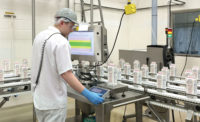When it comes to medical and pharmaceutical manufacturing, errors can be dangerous.
They can also be expensive. Raw materials and parts are pricey, and equipment manufacturers cannot risk defects late in production, which increases scrap and rework and delays shipments.
Quality control— especially QC conducted with rigorous security—makes all the difference. As production environments become increasingly complex, and supply chains become more global, it’s up to manufacturers to find the right Statistical Process Control (SPC) quality management software to prevent defects.
SPC quality control should keep manufacturing processes operating at the highest efficiency. It should closely inspect early production processes and provide quality managers with automated, real-time production-floor data collection, alerts, monitoring, and analysis. It should present that data to the user in an easy-to-understand control chart and should be complete with analytical tools that enable comparative analyses, which can lead to further process improvement.
Medical device and pharmaceutical manufacturers particularly need tools that help them comply with government regulations and other quality and safety standards, such as FDA or internal audits. In this day and age, medical device manufacturers must content with Hazard Analysis and Critical Control Points, Standard Operating Procedures, Critical Quality Attributes and Critical Process Parameters while meeting the FDA 21 CFR Part 11 requirements.
Whether a manufacturer needs to meet CFR Part 11, ISO-13485:2003, or a national regulatory requirement, the SPC system should include, for starters, the following basic security features:
1. A security policy that controls user passwords. It should regulate password age, length and reuse. For example, Infinity QS’ ProFicient’ software has strict access control features that support all of FDA 21 CFR Part 11 technical requirements for electronic signatures including password aging, recycling, lockouts, length, and encryption. The security violation logs track and report individual’s security violations and marks their locations. The software’s access logs track individuals as they log into and out of applications.
2. The software's database should keep an access log to trace system usage and log-in or access violations. For example, ProFicient’s lot genealogy and reporting prowess allows medical device and pharmaceutical manufacturers to follow raw materials or component lot codes throughout manufacturing operations. Lot Genealogy reports deliver a complete vision of the incoming and outgoing products, as well as their statistical summary information. These reports help users to identify materials used in specific lots, areas where raw materials were consumed, root causes of nonconforming lots, current pharmaceutical quality assurance status and numerous other information.
3. The SPC software's database should contain audit tables that capture any changes to database field. These audit records should be easy to see, but not to edit. For example, ProFicient’s database auditing provides complete traceability for any modification, edit, or change to any database record. Traceability records are easy to view, but they cannot be amended. Whenever a user attempts to modify or delete a record, ProFicient’s Reason for Change tracking feature forces users to select a reason for the modification from a drop-down list. Additionally, free-form comments are required. When specified, a Change History and Reason for Change Report can accompany any chart printout.
In today’s increasingly complex world, industry and FDA standards have had to become extremely rigorous to protect the security and health of patients. When choosing an SPC software to ensure quality control on your medical devices and pharma parts, make sure that the software has, at a minimum, these security features.


